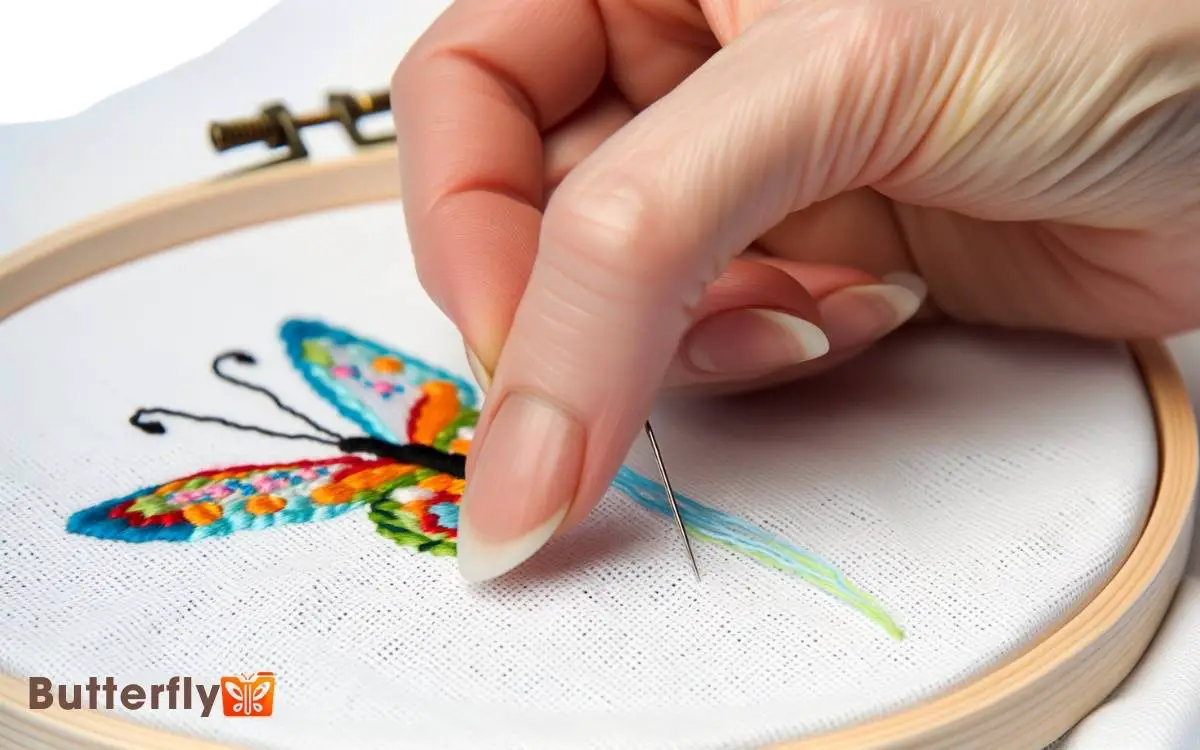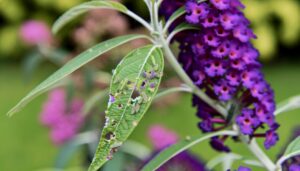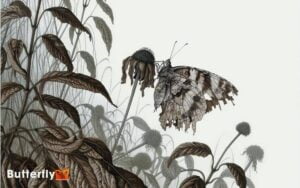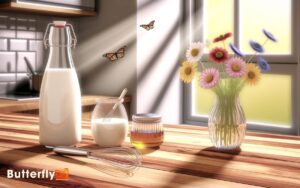How To Embroider A Butterfly? Step-by-Step Guide!
To embroider a butterfly, gather high-quality embroidery floss, a sharp needle, and an embroidery hoop. Prep your fabric by ironing out creases and securing it in the hoop. Transfer your butterfly design using tracing paper or water-soluble pens.
Choose vibrant threads, including metallics for added shimmer. Master basic stitches like backstitch and satin stitch for outlines and wing details. Use long and short stitches for gradients and French knots for texture.
Anchor your stitches securely and trim excess fabric neatly. Display your creation in a frame or as part of a canvas bag. Next, let’s explore the intricacies of each stitch technique.

Key Takeaways
Choose Your Materials
To start your butterfly embroidery project, you’ll need to gather a few essential materials that will bring your design to life with vibrant colors and intricate details.
First, select high-quality embroidery floss in a range of colors to capture the butterfly’s natural beauty. Opt for a sturdy, sharp embroidery needle to guarantee your stitches are precise.
Choose an embroidery hoop that fits your fabric snugly, providing a stable surface to work on. Additionally, a pair of small, sharp embroidery scissors will help you make clean cuts.
For an innovative touch, consider metallic or variegated threads to add dimension and shimmer. These materials will set the stage for a stunning butterfly embroidery that stands out with creative flair.
Prepare Your Fabric
With your materials ready, lay out your chosen fabric on a clean, flat surface to make sure it’s free of wrinkles and debris before you begin. Use a gentle iron to smooth out any creases, as a fundamental base is essential for precision.
Next, stretch the fabric in an embroidery hoop, ensuring it’s taut but not overstretched. This tension will provide the stability you need for detailed stitching.
Secure the screw on the hoop firmly. If your fabric is delicate, consider adding a stabilizer underneath to prevent puckering. This preparation step is vital for maintaining the integrity of your butterfly design.
With your fabric perfectly prepped, you’re now ready to immerse yourself in the artistry of embroidery.
Transfer the Butterfly Design
First, decide on the method you’ll use to transfer your butterfly design options include tracing paper, water-soluble pens, or iron-on transfers.
Carefully position your design on the fabric to make sure it’s centered and aligned as you envision. Secure the design in place to prevent any shifting during embroidery.
Choose Transfer Method
When transferring the butterfly design, you’ve got several methods at your disposal, each offering unique advantages to suit your project’s needs.
For precision, try the iron-on transfer method: simply print your design onto transfer paper and iron it onto your fabric.
If you prefer flexibility, opt for the tracing method using a lightbox or window; place your fabric over the design and trace with a water-soluble pen.
For a more modern twist, digitally print your design directly onto soluble stabilizer, then stitch over it and dissolve the stabilizer in water.
Each method brings its own flair, so choose the one that aligns with your creative vision and the intricacy of your butterfly embroidery.
Position Design Accurately
Now that you’ve chosen your preferred transfer method, it’s time to position your butterfly design accurately on the fabric to guarantee a balanced and aesthetically pleasing final piece. Begin by laying your fabric flat on a clean surface.
If you’re using a lightbox, place your design underneath the fabric and align it to your desired position. For transfer pens or pencils, secure the fabric with masking tape to prevent shifting.
Center the butterfly by measuring equal distances from the fabric’s edges. If symmetry is essential, use a ruler or grid to ensure precision.
Once positioned, lightly mark the fabric’s corners to maintain placement. This careful preparation makes sure your butterfly design captures attention right where you want it, creating a stunning embroidered masterpiece.
Select Your Thread Colors
Explore your thread collection and choose vibrant colors that capture the butterfly’s natural beauty and intricate patterns. Consider the brilliant blues, radiant reds, and dazzling yellows, reflecting the diverse hues found in nature.
Don’t shy away from metallic threads or variegated options; they add depth and shimmer, giving your butterfly a lifelike sparkle.
Lay out your selections and mix and match them to visualize your design. Think about the butterfly’s wings, body, and antennae, ensuring each part stands out yet harmonizes with the whole.
Balance contrast and harmony: use dark threads for outlines and lighter shades for highlights. This meticulous selection process will breathe life into your embroidered butterfly, making it a true work of art.
Master Basic Stitches
To bring your butterfly to life, you’ll need to master a few essential stitch techniques.
- Start with the backstitch for smooth outlines, then explore satin stitches for filling in vibrant wings.
- Practice these stitches on scrap fabric to build confidence before you begin your main project.
Essential Stitch Techniques
Mastering the fundamental stitches, like the satin stitch and the backstitch, will frequently transform your butterfly embroidery from simple outlines to intricate, lifelike designs.
Begin with the satin stitch to fill the wings with smooth, vibrant color. Glide your needle in and out, maintaining even tension to create a seamless, glossy surface.
The backstitch, perfect for defining edges and adding detail, involves inserting the needle backward into the last stitch. This technique guarantees crisp, continuous lines.
For added texture, incorporate the French knot simply wrap the thread around the needle and pull it through the fabric. Experiment with different thread colors and thicknesses to bring your butterfly to life.
Creativity and precision will elevate your work to new heights.
Stitching Practice Tips
A few minutes of daily practice on scrap fabric will greatly enhance your proficiency with basic stitches, making each butterfly you embroider more detailed and vibrant.
- Start with the backstitch for outlining your butterfly wings. Keep your stitches even and consistent.
- Move on to the satin stitch to fill in vibrant sections—practice smooth, parallel lines for a polished look.
- Experiment with the French knot to add intricate dots for texture. Each stitch has its rhythm; mastering them transforms your work from simple to exquisite.
- Use contrasting threads on your practice fabric to see improvements clearly.
- Challenge yourself with small motifs before attempting a full butterfly. Innovative embroidery demands precision and creativity, so let each stitch be a bold step towards your masterpiece.
Outline the Butterfly
Start by selecting a rich, contrasting thread color that will make the butterfly’s outline pop against the fabric. Choose a deep, vibrant hue that brings your design to life.
Thread your needle and begin with a simple backstitch along the butterfly’s outer edge. Make sure your stitches are consistent and tight, creating a defined boundary.
Pay close attention to the curves and angles, making smooth changes to capture the butterfly’s delicate shape.
Don’t rush; precision is crucial. As you progress, periodically step back to admire your work, making sure the outline remains crisp and bold.
This meticulous outlining will serve as the foundation, setting the stage for the intricate details and vibrant colors that will follow in the next steps.
Fill in the Wings
To bring your butterfly to life, start by choosing vibrant thread colors that reflect the natural beauty of its wings.
Experiment with various stitch techniques to create texture and depth, making each section of the wing stand out.
Choosing Thread Colors
When filling in the butterfly’s wings, consider a palette that captures the intricate beauty of nature, blending vibrant hues with subtle shades for a lifelike effect.
Opt for a mix of bold colors like deep blues, radiant purples, and fiery oranges, paired with softer tones such as delicate pinks, gentle yellows, and muted greens.
To add depth, choose threads with a slight sheen or variegated colors, which can mimic the natural iridescence of butterfly wings.
Don’t shy away from experimenting with metallic threads to give a touch of sparkle.
Lay out your chosen threads together before starting to make sure they harmonize well, creating a cohesive and stunning design that brings your embroidered butterfly to life.
Stitch Techniques Overview
Embrace the art of embroidery by using a variety of stitch techniques to fill in the butterfly’s wings, adding texture and dimension to your design.
- Start with the satin stitch to create smooth, glossy areas. This basic stitch will give the wings a sleek finish.
- Next, try the long and short stitch for a gradient effect, blending colors seamlessly.
- Use the seed stitch to add tiny, scattered dots, mimicking natural wing patterns.
- For a bold look, incorporate the French knot to introduce small, raised bumps.
- Finally, experiment with the split stitch for outlining and adding intricate details.
Combining these techniques will make your butterfly’s wings vibrant and lifelike, transforming your embroidery into a stunning piece of art.
Adding Wing Details
Now that you’ve mastered various stitch techniques, let’s focus on adding intricate details to fill in the butterfly’s wings, making them truly enchanting.
Start by selecting vibrant thread colors to bring your butterfly to life. Use varied stitch lengths and directions to create texture and depth. Blend satin stitches with delicate French knots to mimic the intricate patterns on a butterfly’s wings. Layering different shades will add a realistic touch, making your design more dynamic. If you’re curious about how to help an injured butterfly, consider providing a safe space with nectar or a sugar-water solution while it recovers.
Consider these innovative ideas:
- Layered Satin Stitch: For a smooth, glossy finish.
- French Knots: Add tiny spots reminiscent of real butterfly markings.
- Long and Short Stitch: Perfect for blending colors seamlessly.
- Split Stitch: Provides a bold, defined outline.
- Seed Stitch: Mimics the delicate patterns found on butterfly wings.
Experiment with these techniques to craft wings that flutter with life. Your attention to detail will transform your embroidery into a masterpiece.
Add Details and Texture
To truly bring your embroidered butterfly to life, start by using varied stitches and thread colors to add intricate details and engaging textures. Experiment with techniques like French knots for the butterfly’s eyes, creating a realistic, three-dimensional effect.
Use satin stitches to give the wings a glossy, smooth finish, while combining long and short stitches for a gradient effect that mimics natural wing patterns. Incorporate metallic threads to add a touch of shimmer, reflecting light like real butterfly wings.
Don’t hesitate to blend multiple thread colors within a single section, creating a dynamic, lifelike appearance. By varying stitch lengths and directions, you’ll add depth and movement, transforming your butterfly from a simple embroidery into a stunning piece of art.
Secure Your Stitches
Ensuring your stitches are secure is essential for maintaining the integrity and longevity of your embroidered butterfly.
Here’s how to perfect this vital step:
- Anchor knots: Begin and end with small, tight knots to keep threads in place.
- Backstitch lock: Use a backstitch at the end of each thread to prevent unraveling.
- Double thread: For added strength, use a doubled thread while stitching.
- Underlay stitching: Implement underlay stitches that act as a foundation for more complex designs.
- Thread conditioner: Apply a thread conditioner to minimize fraying and tangling.
Finish and Display
Showcase your embroidered butterfly by expertly finishing the edges and selecting a display method that highlights your craftsmanship.
Start by trimming any excess fabric around your design, leaving a small margin. Use a blanket stitch or fray check to secure the edges neatly.
Next, consider innovative display options. Try mounting your butterfly in a shadow box for a 3D effect, or stretch it over an embroidery hoop and paint the hoop’s rim for added flair. You could also frame it with a floating glass frame to emphasize the intricate details.
For a modern twist, attach it to a canvas or tote bag, transforming your art into a functional piece. Embrace creativity and let your butterfly take flight!
Conclusion
You’ve chosen your materials, prepared your fabric, and transferred the butterfly design.
You’ve selected your thread colors, mastered basic stitches, and filled in the wings.
You’ve added details and texture, secured your stitches, and finished your masterpiece.
Now, step back and admire your work, display it proudly, and savor the satisfaction.
Embroidery isn’t just a craft; it’s an art, a passion, a journey.
You’ve transformed fabric and thread into a vibrant butterfly that’s uniquely yours.






